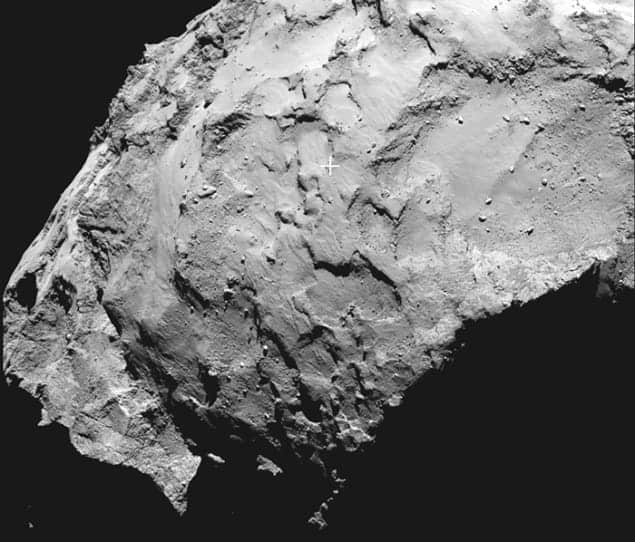
The European Space Agency’s Rosetta mission has pinpointed the spot where its Philae landing module will touch down on the surface of a comet in November this year. The site, along with a second “back-up” location, has been chosen after much deliberation, and sits in the “head” of the comet – an area that is thought to be relatively flat and devoid of large boulders.
The region, dubbed Site J, was one of five locations that the team considered as potential landing sites on the oddly shaped Comet 67P/Churyumov–Gerasimenko, which is just over 4 km across at its widest point. The 100 kg Philae should reach the comet’s surface on 11 November, if all goes to plan. Images taken by Rosetta in July showed that the comet’s nucleus is made up of two distinct segments joined by a “neck”, giving it a “rubber-duck”-like appearance. The team revealed earlier today that the decision to select Site J as the primary site was unanimous. The back-up Site C is located on the “body” of the comet. Once at either of the sites, Philae will begin making in-depth measurements to characterize the nucleus in situ, providing researchers with a unique insight into the composition, structure and evolution of a comet.
Site selection
“As we have seen from recent close-up images, the comet is a beautiful but dramatic world – it is scientifically exciting, but its shape makes it operationally challenging,” says Stephan Ulamec, at the DLR German Aerospace Centre, who is the project manager for the lander.
Finding the prime landing site on Comet 67P was no easy task – none of the five chosen sites met all of the criteria preferred by the team, but site J is touted as the best solution. While the shortlist of five sites had been identified on 24 August, the spacecraft was still 100 km from the comet. Since then, the spacecraft has moved to within 30 km of the icy body, allowing the researchers to make more detailed scientific measurements of all five sites. This past weekend, engineers and scientists from Philae’s Science, Operations and Navigation Centre at France’s CNES space agency, along with researchers at the Lander Control Centre at DLR and the Rosetta team, met at CNES, Toulouse, France, to consider the available data and choose the primary and back-up sites.
The group considered a number of key factors, including the identification of a safe trajectory for sending Philae to the surface, as well as making sure that there were minimal visible hazards in the landing zone. Other factors, including the balance of daylight and night-time hours at potential landing sites and how often the lander could communicate with the rest of the orbiting spacecraft, were also considered. According to the statement from the Rosetta team released today, the “descent to the comet is passive and it is only possible to predict that the landing point will place within a ‘landing ellipse’ typically a few hundred metres in size. A one-square-kilometre area was assessed for each candidate site. At Site J, the majority of slopes are less than 30° relative to the local vertical, reducing the chances of Philae toppling over during touchdown”. The site also has fewer boulders and receives the right amount of sunlight each day to recharge Philae and continue science operations on the surface beyond the initial battery powered phase.
Perfect landing?
For the trajectory that the team has currently plotted, the lander should take about seven hours to reach the surface – a duration that does not compromise the on-comet observations by using up too much of the battery during the descent. Once deployed from the main Rosetta spacecraft, Philae will be on its own, with all of its commands already prepared and uploaded before it separates from the craft. Indeed, the module will be taking images and making other observations of the comet’s environment even as it descends. The landing itself should take place at a walking pace, and the module will use harpoons and ice screws to fix itself onto the surface. It will then make a 360° panoramic image of the landing site to help determine where and in what orientation it has landed.
For now, the Rosetta team will come up with a detailed plan of how the spacecraft will approach the planned trajectory to make its landing, which must take place by mid-November, because the comet is predicted to grow more active as it moves closer to the Sun. The landing date should be confirmed on 26 September after further trajectory analysis, and the final call to land at Site J will be made on 14 October.
Timely target
“There’s no time to lose, but now that we’re closer to the comet, continued science and mapping operations will help us improve the analysis of the primary and back-up landing sites,” says ESA Rosetta flight director Andrea Accomazzo. “Of course, we cannot predict the activity of the comet between now and landing, and on landing day itself. A sudden increase in activity could affect the position of Rosetta in its orbit at the moment of deployment, and in turn the exact location where Philae will land, and that’s what makes this a risky operation.”
Assuming that all goes well with Philae’s landing, the module will be studying the plasma and magnetic environment, and the surface and subsurface temperature. The lander will also drill and collect samples from beneath the surface, delivering them to the on-board laboratory for analysis. The interior structure of the comet will also be explored by sending radio waves through the surface towards Rosetta.




